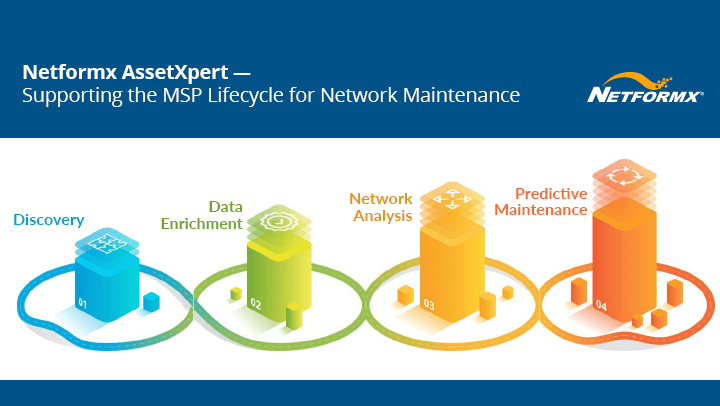Blogs

Vice President of Business Development & Customer Success – Retired
More about Pete Eggimann
All Solution Providers are pursing digital transformation initiatives with different motivations. But what does that mean for your core workflow and what can be done to optimize your existing process?
How is Netformx Transforming?
You may have noticed I have a new title – VP Customer Success. It reflects a formalization of how we engage with customers to understand how they get the most value from our products and to help them on their transformation journey.
Great – what have you learned and why do I care?
As you might expect, we receive a lot of customer input on where we can improve and enhance our products and support processes. No surprise there, and we endeavor to act on it with urgency and agility.
What I didn’t expect (or perhaps I should have) was the bigger opportunity for a solution provider to extract significant additional value from our solution offerings by connecting the dots and integrating them into their end to end workflow and processes.
So, what is workflow integration and how do we measure value?
When I think of a solution provider workflow and how we integrate and optimize that workflow with the Netformx suite of applications, I look at the following opportunities:
- Connecting the dots in the configuration, price, quote, cash workflow
- Adding value by optimizing each step of the workflow
- Elimination of manual steps in the workflow process
And I think of delivering and measuring value in the following ways:
- Professional services attach – How do I easily quote professional and managed services?
- Increasing deal velocity – How do I get a quote to a customer faster than my competition?
- Optimizing deal margin – How do I take advantage of deals, promotions, early in the process?
- Operational controls – How do I manage, optimize, report on my business more efficiently?

Let’s put a spotlight on a typical workflow showing how we are connecting many of these process steps and delivering value:
- Step 1: Opportunity Creation. The first step in a typical workflow is for Sales to create the opportunity in the CRM system. When the opportunity is created, he or she can assign someone to perform the design. This will automatically create a project in the Netformx HUB repository using the opportunity name and number as part of the naming convention. These steps are enabled by a CRM adapter created by Netformx.
space - Step 2: HUB Project Creation and Sharing. The owner of design specified during the opportunity creation is notified in SalesXpert if it is a run-rate design, or DesignXpert if it is a complex design, and in both cases, via email. The benefit of storing the project in the HUB is to provide the ability to collaborate on this design within and between teams, with the final step to share back to the Sales person who owns the opportunity.
space - Step 3: Professional Services Advisor. As part of the design process, you’ll also notice the ability to attach professional services to each design and automate the mapping of SKUs in the design to these services. This automated process is enabled using an administrative process to create the “Rate Cards” that drive the professional services activities for each SKU in the design. The Sales Engineer has the ability to override and customize the professional services by changing the default rate card assignments.
space - Step 4: Commercial Optimization of the BOM. Optimization of the BOM from a commercial perspective early in the design process is critical to leverage VIP and other Cisco incentives further in the downstream workflow. This commercial optimization is facilitated using BOM Analyzer, which is a built-in feature of DesignXpert and SalesXpert. BOM Analyzer will make those optimization recommendations, as well as suggest alternate SKUs for consideration in the design.
space - Step 5: Creation of the CCW Estimate. The next step in the workflow is to create the CCW Estimate. The Estimate can be created from the BOM using either DesignXpert or SalesXpert with a simple upload button to update an existing Estimate or create a new Estimate. Note that in our example, the simple run-rate designs created by the inside sales teams typically do not go through the GRD process, and therefore often do not have estimates created in CCW.
space - Step 6: Analyzing the Deal Margin. Once the Estimate is in CCW, we analyze the Estimate and map the SKUs in the estimate to the best possible front-end programs and incentives using the Partner Incentive Tool (PIT). PIT educates and guides the sales and inside sales teams on the best way to take advantage of multiple programs and incentives to obtain the best cost discounts from Cisco prior to registering the deal.
space - Step 7: Registering the Deal. The user will take the guidance provided by the PIT and go through the Cisco Guided Deal Registration (GDR) process to obtain the cost structure of that BOM. This process requires the approval by the Cisco PAM for any programs and incentives requested on the Deal. The result is an approved Deal and associated cost discounts.
space - Step 8 and 9: Import the Cost Discounts. Once the Deal is approved by Cisco, the cost discounts associated with the deal is imported back into DesignXpert to allow for the sales and finance to take the next step. Using the cost discounts, Netformx provides a Margin Analysis Tool (MAT) to analyze and manipulate the margins by category or SKU, add uplifts, additional discounts, etc. Sales will then generate and present the quote to the customer.
space - Step 10: Update the Opportunity. Once the design is completed and commercially optimized, the deal registered, and the margins established on the deal, the BOM and customer quote can be written back into the CRM opportunity record with one click in either DesignXpert or SalesXpert. And the best part is not everyone in the organization needs access to the CRM system. The BOM, and quote can be shared via the HUB repository back to the sales person creating the opportunity as part of the workflow.
At this point, I think you can see many opportunities to optimize a typical workflow. And hopefully the benefits can be clearly seen in terms of deal velocity, professional services attach, cost and margin optimization.
We’ll continue to do blogs with a deep dive on different workflow optimization techniques using the framework described above.
Or maybe not. Tell me if we are on the right track discussing topics that interest you, or if you have other suggestions on what we should focus on that’s keeping you up at night …







